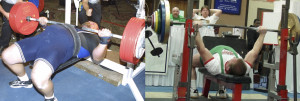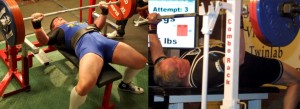By Dan Wagman, Ph.D., C.S.C.S.

IPF World Bench Press Champions and world record setters Dan Gaudreau (l) and Dan Wagman (r) would receive red lights for the new USAWA hamstring violation.
When I submitted an edit to USAWA’s bench press rule for consideration at the most recent yearly National Meeting, my sole objective was to provide lifters with the legal means to place plates or blocks under their feet if needed. That edit would conform with internationally accepted powerlifting norms as stated in the International Powerlifting Federation (IPF) technical rules. I even submitted the wording that would most easily and directly address this—just one brief sentence. Who could have predicted that such basic wording would end up garbled to the point of rendering the rule edit absurd?
According to the Minutes, some members felt that language should be added “to make clear what the lift should look like” in an effort to avoid “distorting the lift.” As a result, the language added does exactly that—distort the lift. First, it only allows a lifter to use blocks and not plates if that’s all that’s needed. But second, it most ludicrously requires the hamstrings to remain “in contact with the bench.”
That requirement is absurd because for many lifters it’s nearly impossible to have the hamstrings remain in contact with the bench while performing a technically proficient bench press.
To be clear, the internationally accepted standards and USAWA’s original rule only call for the head, shoulders, and buttocks to be in contact with the bench. For USAWA to now require the hamstrings to also remain in contact with the bench represents a fundamental departure of decades old standards. That requirement is absurd because for many lifters it’s nearly impossible to have the hamstrings remain in contact with the bench while performing a technically proficient bench press. First, it must be understood that the hamstrings constitute a group of three different muscles at the back of the thigh. How does a lifter get muscles at the back of the thigh to maintain contact with the bench? Well, the lifter could lay at least a portion of the back of the thighs on top of the bench or perhaps squeeze the outer edges of the bench with some back That requirement is absurd because for many lifters it’s nearly impossible to have the hamstrings remain in contact with the bench while performing a technically proficient bench press. portion of the thighs. Of course if you did the former and your legs are not long enough, foot contact with the ground would be compromised. Use of a wide stance foot placement that provides optimal transfer of forces from the floor to the barbell via a solid anchor and back arch is also out because doing so rotates the back of the thighs off/away from the bench. In addition, if you consider each lifter’s unique thigh-to-leg ratios in combination with the different bench length and width dimensions you can run in to at all-round meets, a nearly infinite number
For lifters with long legs, or a bench with less height, loaders would have to place the bench on blocks…
of different block heights would be required to accommodate this new rule. Also, what if the bench length is such that a tall lifter can only place his/her head or hamstrings on the bench at the same time? Of course, for lifters with long legs, or a bench with less height, loaders would have to place the bench on blocks to accommodate the hamstring-bench-contact requirement. Frankly, “absurd” is an understatement. So, what started out as a very simple edit to the existing bench press rule ended up diverting from international norms and has turned one of the most basic tests of maximal strength into a nightmare for many lifters. How does something like this happen? With the exception of omitting the plates and blocks allowance the original USAWA rule was perfectly aligned with international standards. So perhaps the more important question is: how does the organization correct this atrocity and do so before the next meet that will contest a version of the bench press which could be any Record Day and specifically the Postal Series National Championship at the end of the year? If the organization does not make corrections, one of two things will happen: 1) meet refs will see that adhering to this rule is impossible for many lifters and will ignore it; 2) lifters like me will simply not perform the bench press and its variations. Neither choice enhances USAWA’s credibility as a strength sport.

Turning perfect bench presses into red lights. Different views of the same hamstring violation.

